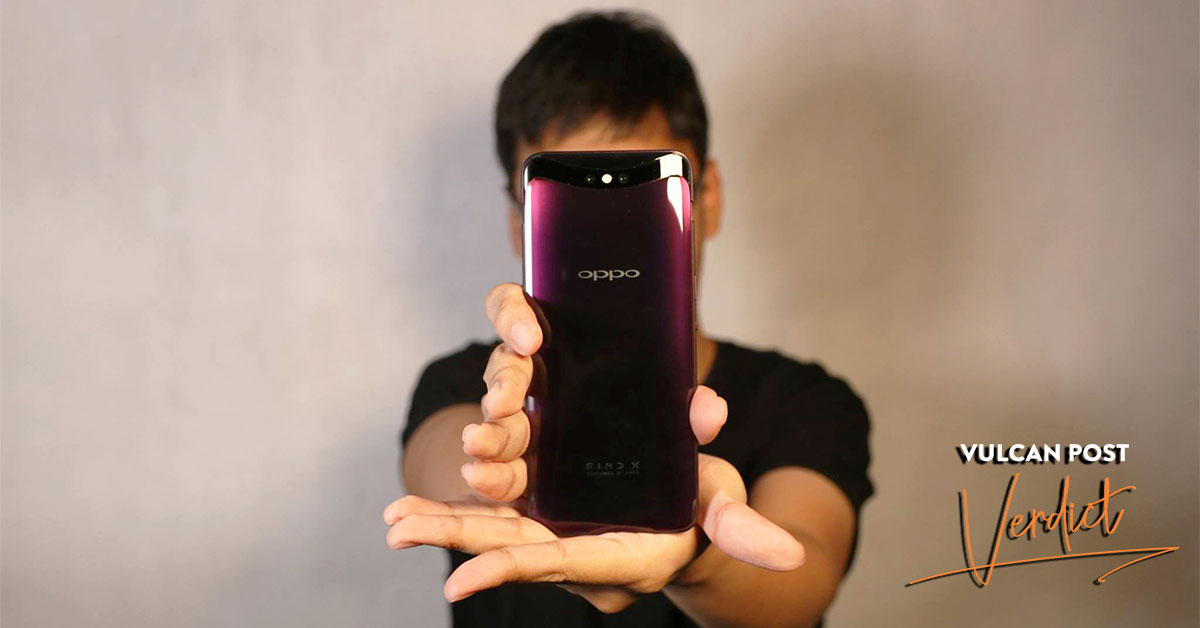- The Find X is the latest flagship from Chinese phone manufacturer Oppo.
- It boasts a bezel-free display with a motorised camera module that hides both front and back cameras inside the body of the phone.
- Pricing for the Find X officially starts at RM3,699.
The quote most applicable to the Oppo Find X—as cliché as it may sound—is this: “Dare to be different.”
In the race to create a completely a bezel-free smartphone, manufacturers are attempting various methods to maximise screen real estate. iPhone and a slew of Android brands have mainstreamed the notch, Samsung has its edge-to-edge infinity display, and some have found interesting ways to deal with the front-facing camera and fingerprint scanner.
But in terms of zero bezel, all these implementations failed to achieve that goal until two Chinese manufacturers—Vivo and Oppo—both unveiled two new flagships earlier this year.
Both the Vivo NEX S and the Oppo Find X, when they were announced in Q2 2018 were head-turning devices that both managed to hit the goal of a completely bezel-free display. Both devices also did it by doing the same thing—having motorised cameras hidden inside the body.
Unsurprisingly however, it was the Oppo (despite its premium price tag of RM 3,699) that grabbed more attention due to its sleeker implementation and overall better looks—it had the camera module pop up as a full piece rather than just a small block like the Vivo did, and it overall just looks better in every way.
But more than being just a fashion statement, the Find X is also packed to the rafters with today’s latest trimmings. Here’s how it holds up in the wild.
Hardware
Before we talk about how the Find X performs, let’s run through the specs first.

On paper, the Find X is similar specwise to many competing flagships in the market, sporting a top-of-the-line Snapdragon 845, 8GB of RAM, a dual camera setup with optical image stabilisation on the main lens, and a vibrant 6.4 inch AMOLED display among others.
However, it’s when you hold it in your hand that you notice just how special this phone is. From the front, the screen immediately grabs your attention with its display reaching from end-to-end, curving around the sides the same way Samsung’s latest flagships do.
On the back, the theme is pretty much the same, with the facade completely void of any tech and only sporting the Oppo and Find X logos, making the phone look exceptionally sleek.
But while there is no notch to speak of, there also isn’t a fingerprint scanner on the front nor on the back, which is a real puzzlement by today’s standards. While the lack of a 3.5mm jack has become more common, it’s still a shame that the Find X does not have one either.
|
Hardware Specs |
|
| Display | 6.42 inch AMOLED panel, 1080 x 2340 pixels, 19:9 aspect ratio |
| Dimensions & Weight | 156.7 x 74.2 x 9.4 mm (6.17 x 2.92 x 0.37 in), 186 grams |
| Camera | Dual Rear Camera: 16MP primary shooter + 20MP secondary camera
Front: 25MP |
| Processor | Qualcomm Snapdragon 845 |
| Memory | 8GB RAM |
| Storage | 128GB/256GB, no expandable storage |
| Battery | 3,730 mAh |
Performance
Now when it comes to the actual use of the Find X, most of the experience is actually fairly similar to most flagships found in the market.
Its Snapdragon 845 and 8GB of RAM provide blazing fast speeds when it comes to daily use, and in terms of battery life, the Find X actually comes out as one of the best performers, its 3,730 mAh battery easily providing a day and a half’s worth of power on a full charge (which can be attained really quickly thanks to its proprietary VOOC Charging that is pretty much the same as OnePlus’ insanely fast Dash Charging technology).
All this is accentuated by the gorgeous display, with media consumption and gaming made extra immersive and enjoyable thanks to the lack of bezel and the OLED’s vivid colours and striking contrast.
Wherever I went, the Find X never failed to grab attention from people around me, each and every one of them quickly charmed by the camera model, sleek build, and huge screen.
In terms of software, however, the Find X isn’t without its flaws. ColorOS—Oppo’s version of Android—isn’t the most intuitive and comes with a fair bit of bloatware that just hampers the overall experience. I’ve always maintained my preference for having stock Android ahead of any other skinned version of Google’s operating system, and the Find X reaffirmed that opinion once again.
For example, while other phones allow you to dismiss notifications with a simple swipe towards the edge of the screen, the Find X necessitates that you swipe left and then also click a button to do the exact same thing, making it a two-step process.
Then there’s also the lack of an app drawer, something that I find really useful when it comes to organising my home screen. There’s also the separate Oppo App Store that seems quite pointless considering that Google’s Play Store serves the exact same purpose and more.
Camera
Moving on to the camera, I find myself in another weird predicament. With so much emphasis placed on having a special camera module, you’d expect the actual cameras themselves to be category winners, right?
Not exactly.
For the most part, the Find X performs quite satisfactorily in well-lit conditions, with colour-depth and details coming nicely and complementing the snappy camera app. For the everyday user, using the Find X to take group photos, scenery shots, and foodie photos will be no problem.
But it’s in dimly lit conditions where things start to dip quite a bit, with night shot photos coming out grainy or underexposed depending on which trade-off you go with. For those that like doing night photography, this phone is probably not the choice.

Another thing to note, while the camera module is nice and all, it’s also a bit counterintuitive, with it every so often clipping my fingers when switching between the camera app and the photo gallery—this is because the module always retracts back into the body when you’re not on the camera app.
Verdict
Put simply, I find the Oppo Find X (see what I did there?) to be a strange product in terms of whether or not I can recommend it for the everyday consumer. One on hand, the phone comes packed with a suit of intriguing features—one of which literally can’t be found anywhere else.
On the other hand, there are also problems that would theoretically cause me to hesitate when if it came down to me hitting the checkout button.
Yes, the performance is undeniably top-notch, and it’s an amazing phone for heavy media consumers, however, there are quite a few things that prevent it from being daily-use material, especially when it costs RM3,699.
In summary, here are the pros and cons:
|
Pros |
Cons |
| Unique, head-turning design | ColorOS is clunky and not intuitive |
| Screen is notch-free and bezel-free | Camera module isn’t that secure, and traps dust easily |
| Vibrant OLED screen | Camera doesn’t perform well in low-light |
| Great battery life, really fast charging | No fingerprint scanner, headphone jack, or expandable storage |
| Premium build quality | Moving parts have a higher chance of failure |
But still, my final word on the Find X is this: I absolutely love that phone companies are continuously trying to make things better for the consumer.
While the Find X isn’t perfect in its execution where trying to achieve a bezel-less phones is concerned, I sincerely hope that Oppo doesn’t stop trying. If anything, I hope to see a Find X2, a Find XI, a Find Y, or whatever they want to call the successor to this flawed beauty. I for one believe that if they heading down this path, they’ll get it right eventually.
- To know more about the Oppo Find X, visit the official website here.
VP Verdict is a series where we personally try and test out products, services, fads, and apps. Want to suggest something else for us to try? Leave a comment here or send the suggestion into our Facebook page.














